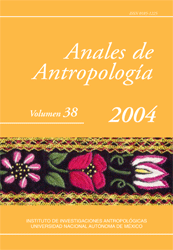Un ritual funerario náhuatl. Urnas cinerarias de Zihuateutla, Puebla
Main Article Content
Abstract
In Zihuateutla, a municipal entity of the Sierra Norte de Puebla, an assemblage of 65 cinerary urns, 55 containing burnt human remains, was found. The sample was excavated without record. Never the less, the material were analyzed and the results were historically contextualized in the latest prehispanic period (1450-1550 AD) for which there are some historical accounts. With these elements we propose a set of inferences about the cause and meaning of this funerary context. In first place, it was established that the ethnic adscription of the group was Nahuatl, this inference is based in the vessels style and in the historical accounts that records the establishment of Nahuatl colonies in the region. In second place we established that the cremation of the bodies and the placing of the urns were, both, a single event, so the third point is an explanation for the sudden death of a group of people. Four possible causes were explored: natural disaster, epidemics, sacrifice and violent death. The data points out that the last one was the more plausible explanation.
Downloads
Download data is not yet available.
Article Details
How to Cite
Núñez Hernández, L. F. (2010). Un ritual funerario náhuatl. Urnas cinerarias de Zihuateutla, Puebla. Annals of Anthropology, 38(1). https://doi.org/10.22201/iia.24486221e.2004.1.16579
Citas en Dimensions Service
Esta revista usa una licencia CC del tipo CC BY-NC-ND 3.0. Se maneja bajo el esquema de acceso abierto, con una licencia Creative Commons Attribution-NonCommercial-NoDerivs 3.0 Unported.
